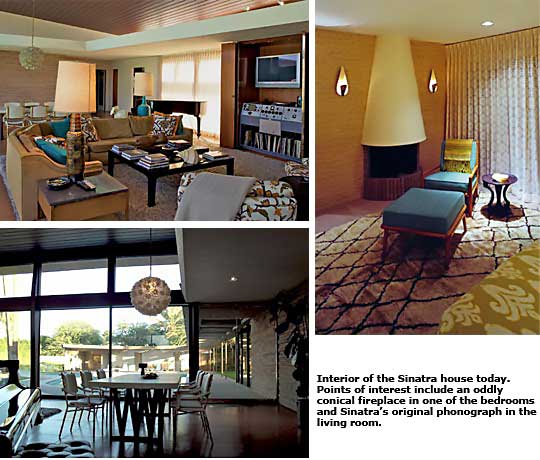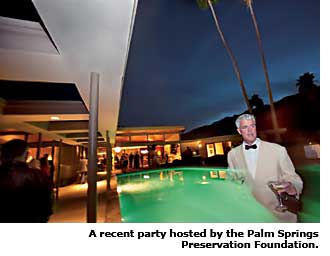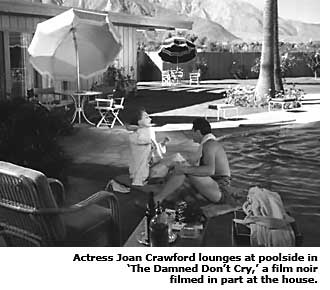One Voice, Twin Palms - Palm Springs - Page 2
During Frank's heyday, girls swooned, GIs cheered, and a riot broke out at New York's Paramount Theater when fans feared they wouldn't be able to get inside. A fan once called Frank "one of the greatest things to ever happen to Teen Age America," but by 1947 Teen Age America had moved on.

Frank had lost his cuddlesome, boy-next-door image. He was accused of being a mobster after being photographed in Havana with Lucky Luciano, Senator McCarthy called him a "Communist Fellow Traveler," and Frank was denounced from America's pulpits for running around with Lana Turner despite his marriage to his hometown sweetheart, Nancy Barbato.
Record sales were plummeting and reviews turned sour. Worse, at a concert in 1950 Frank opened his mouth and, in his own words, what came out was 'dust.' His vocal cords had hemorrhaged. His record label dropped him in 1952, his talent agency too.
By 1948, Frank and Ava Gardner were necking in Los Angeles. By 1949, in Palm Springs, Ava recalled, "He told me, under the stars, that his marriage was through. Then he sang to me under a palm tree." Later that year Frank and Ava cruised the desert in his Cadillac convertible, shooting streetlights with .38s until the law caught up to them.
Following a Nevada divorce Frank and Ava married, commencing what Lana Turner, who remained Frank's friend, called "a dreadful farce." "We never fought in bed," Ava said.
Sinatra was besotted. Arranger Skitch Henderson said Ava was Frank's "Svengali," and compared her to a panther. She was by far the more successful star—though, surprisingly enough, that fact contributed to what marital happiness they shared.

"When he was down and out, he was sweet," Ava later said. "But now that he's successful again, he's become his old arrogant self." Both were intensely jealous, and apparently had reason to be.
They separated 11 months after marrying. By 1953, thanks to 'From Here to Eternity,' a movie that gave Sinatra an Oscar for best supporting actor, he was a star again.
With money in his pocket, Sinatra moved out of the house in 1954 to much larger desert digs alongside the Tamarisk Country Club in Rancho Mirage. "The Compound," as this home became known, was originally designed by another famed desert modern, William ('Wild Bill') Cody. Over the years the house grew and grew. Today, according to Donald Wexler, yet another Palm Springs architectural great, "I don't think you could find the original house, it's been added onto so much."

A worse fate almost befell Twin Palms. By the mid-1990s, Merchell recalls, the pool was an empty hole, the lot overgrown, and a contractor hoped to bulldoze it. Palm Springs was at its nadir and Sinatra's wasn't the only abandoned house in the neighborhood. "It was sold as a teardown," Merchell says.
The Sinatra house!? Really!?
"I think it was totally forgotten," Miller says of Twin Palms. "Most of the Sinatra interest focused on his house in Rancho Mirage where he lived for 40 years."
Along came Marc Sanders, a landscape designer who had been buying and restoring homes in the neighborhood for several years, including the house Don Wexler designed for himself. "Bit by bit he helped fix up the whole neighborhood," Merchell says.
Sanders, intrigued by what little he could see of the overgrown Sinatra house, visited when it came on the market in 1997 and bought it for $137,000. "I kind of fell in love with the house because of its architecture," he says. He had no idea Sinatra had owned it—until he checked its original building permit while the house was in escrow.

Sanders wanted to find out who designed the house, which wasn't recorded. But the name of the owner was. "Oh God, that's kind of a fun story," was his reaction on seeing the name Sinatra. "But I wanted to find out who the architect was."
He found that out when a friend saw a photo of the house in an exhibit by Julius Shulman.
Sanders, who has restored 27 houses in his career, including Stew Williams' own house, spent $400,000 to renovate the Sinatra house, though he'd been warned off. "Friends told me, there's no way you can do anything with this house." Sanders sold it in 2000 for $1.3 million.




